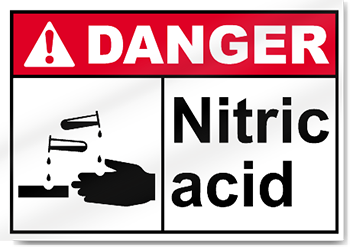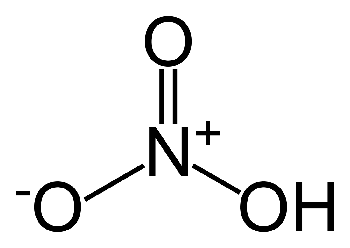Nitric Acid Safety
 Nitric acid is not only a strong acid that is extremely corrosive but it is also a potent oxidizer. Bretherick’s Handbook of Reactive Chemical Hazards states that “Nitric acid is the common chemical most frequently involved in reactive incidents… and this is a reflection of its exceptional ability to function as an effective oxidant even when fairly dilute (unlike sulfuric acid) or at ambient temperatures (unlike perchloric acid). Its other notable ability to oxidize most organic compounds to gaseous ‘nitrous fumes’ has been involved in many of the incidents in which closed, or nearly closed, reaction vessels or storage containers have failed from internal gas pressure.” Nitric acid is not only a strong acid that is extremely corrosive but it is also a potent oxidizer. Bretherick’s Handbook of Reactive Chemical Hazards states that “Nitric acid is the common chemical most frequently involved in reactive incidents… and this is a reflection of its exceptional ability to function as an effective oxidant even when fairly dilute (unlike sulfuric acid) or at ambient temperatures (unlike perchloric acid). Its other notable ability to oxidize most organic compounds to gaseous ‘nitrous fumes’ has been involved in many of the incidents in which closed, or nearly closed, reaction vessels or storage containers have failed from internal gas pressure.”
 Nitric acid reactions can occur over time and may not be immediate. Click on the video above to view a demonstration of the slow reaction of nitric acid
mixed with ethanol as well as a visual demonstration of the large volume of nitrogen dioxide gas formed by the reaction. This clearly shows the need to properly label dump jugs and to be knowledgeable of the reactive properties and compatibility of the chemicals being added to dump jugs. Nitric acid reactions can occur over time and may not be immediate. Click on the video above to view a demonstration of the slow reaction of nitric acid
mixed with ethanol as well as a visual demonstration of the large volume of nitrogen dioxide gas formed by the reaction. This clearly shows the need to properly label dump jugs and to be knowledgeable of the reactive properties and compatibility of the chemicals being added to dump jugs.
Nitric acid is incompatible with many organic materials and reacts with water to produce heat. Nitric acid can generate hydrogen gas on contact with certain metals (e.g., aluminum) and decomposes on warming producing nitrogen oxides. Nitric acid is a strong oxidant and reacts violently with combustible and reducing materials (e.g., turpentine, charcoal, alcohol). The substance is a strong acid: it reacts violently with bases and also reacts very violently with organic chemicals (e.g., acetone, acetic acid, acetic anhydride, and alcohols), causing fire and explosion hazard. Nitric acid also reacts explosively with metallic powders, carbides, cyanides, sulfides, alkalis, and turpentine.
 Store nitric acid in the original container (dilute solutions must be stored in acid-resistant bottles) and don’t store nitric acid near materials with which it may react. Store nitric acid in its own storage cabinet near floor level and if a dedicated storage cabinet is not available, store nitric acid with inorganic acids, segregated from the other acids in secondary containment (a plastic bin, tub or tote). Store nitric acid in the original container (dilute solutions must be stored in acid-resistant bottles) and don’t store nitric acid near materials with which it may react. Store nitric acid in its own storage cabinet near floor level and if a dedicated storage cabinet is not available, store nitric acid with inorganic acids, segregated from the other acids in secondary containment (a plastic bin, tub or tote).
Nitric acid should only be used in a certified chemical fume hood that is clear of organics, flammables and other incompatible substances. Chemical splash goggles and a full face shield should be worn because safety glasses with side shields will not offer adequate protection should splashing occur. A lab coat and a chemical splash apron (made of neoprene, viton, or other material which cannot be permeated or degraded by nitric acid) are recommended when handling nitric acid and never wear shorts, skirts above the knee or open-toed shoes when handling nitric acid or other corrosive chemicals. Neoprene gloves should be worn when handling the acid and only use in a laboratory equipped with a working emergency eyewash and emergency shower.
Please use caution when storing, handling and disposing of nitric acid into a waste jug. Only you can prevent an explosion or exposure due to improperly handling nitric acid. |